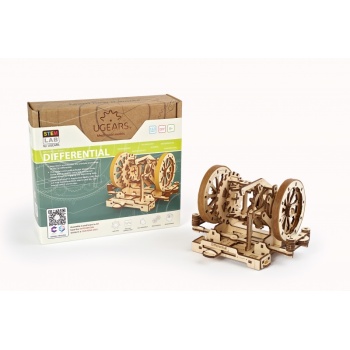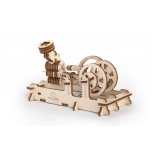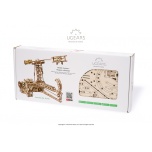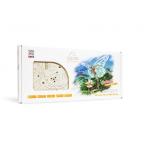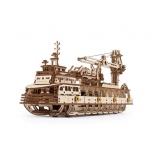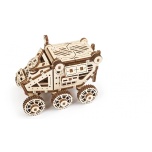UGEARS STEM LAB Diferentsiaal
Hind:
19,90 €
Auto diferentsiaali mudel UGEARS STEM haridus seeriast.
Õpi kuidas mehanismid töötavad ja vaata UGEARSI rakenduse abil liitreaalsuses, kuidas ja kus neid kasutatakse.
Mudeli suurus: 7.5 * 13.5 * 10.5 cm
Pakendi suurus: 20.5 * 18.8 * 6.3 cm
Detailide arv: 163
Eeldatav koostaeg: 1-2 h
Model Size: 6.9 * 5.3 * 4.1 in (17.5 * 13.5 * 10.5 cm)
Package size: 8.1 * 7.4 * 2.5 in (20.5 * 18.8 * 6.3 cm)
Number of components: 163
Estimated time for assembly: 1-2 hours
Differential
Model Size: 6.9 * 5.3 * 4.1 in (17.5 * 13.5 * 10.5 cm)
Package size: 8.1 * 7.4 * 2.5 in (20.5 * 18.8 * 6.3 cm)
Number of components: 163
Estimated time for assembly: 1-2 hours
o Assemble it and discover the principle of working of the Car Differential.
o Experiment: the model comes with a Pocket Model’s Study Guide with a creation
story and mechanism design as well as engaging and interesting tasks.
o Immerse yourself in Augmented Reality (AR), find out how the Counter is used in
a production line, and interact with it via the dedicated Ugears application.
Learn how the DIFFERENTIAL works:
The Differential is a stylised educational model, an interactive study guide to the
mechanism, only for learning its essentials and principles of working. The Differential was
designed to ensure that the drive wheels sitting on the same axle rotate with a different rate
and cover different distances at the same time. This mechanism allows the car to make
turns without the wheels skidding, prevents wheel-slip, reduces tyre wear, and makes
entering and going out of turns easier for the driver. Having assembled the Differential, your
can unblock it pushing the lever in position 1 (Up) and set both wheels in motion by rotation
of the drive gear or the wheel. The Control lever regulates the smooth locking of the left and
right wheels independently by turning left or right respectively. In the “down” position of the
lever, both wheels are linked in a rigid coupling and can either rotate together (propelled by
the drive gear or a wheel) or lock simultaneously (by the lever of the wheel).
When and who invented it:
The car differential was invented by French engineer Onesiphore Pecqueur in 1825. In the
1930s of the 20th century, German automotive engineer Ferdinand Porsche made
significant improvements to the device.
Usage:
Differentials are used mainly in cars as a part of the transmission mechanism. They improve
manoeuvrability and performance of a car.
The mechanism of the Differential is composed of:
• The drive gear
• The locking lever
• The side gear
• The locking clutch
• The wheel
The Differential is developed to serve as a learning tool rather than a puzzle. Just like the rest of
Ugear’s collections, putting STEM-lab models together is fun and comprehensive: everything you
need to build, learn and discover comes in a box. There you will find:
• High-quality wooden boards with pre-cut details and other standard supplies. Assembly
requires no glue or additional tools. The details come out of the boards with a slight push.
• Detailed step-by-step color instruction manual. Easy to follow – easy to learn.
• Examples and suggestions for your fun hands-on projects.
• QR-code to Pocket Model’s Study Guide (the Differential Essentials with description of the
mechanism, principle of working, main characteristics, definitions, and formulas).
• QR-code to Ugears AR Application. New exciting feature from Ugears to make your learning
experience even more fascinating!
Õpi kuidas mehanismid töötavad ja vaata UGEARSI rakenduse abil liitreaalsuses, kuidas ja kus neid kasutatakse.
Mudeli suurus: 7.5 * 13.5 * 10.5 cm
Pakendi suurus: 20.5 * 18.8 * 6.3 cm
Detailide arv: 163
Eeldatav koostaeg: 1-2 h
Model Size: 6.9 * 5.3 * 4.1 in (17.5 * 13.5 * 10.5 cm)
Package size: 8.1 * 7.4 * 2.5 in (20.5 * 18.8 * 6.3 cm)
Number of components: 163
Estimated time for assembly: 1-2 hours
Differential
Model Size: 6.9 * 5.3 * 4.1 in (17.5 * 13.5 * 10.5 cm)
Package size: 8.1 * 7.4 * 2.5 in (20.5 * 18.8 * 6.3 cm)
Number of components: 163
Estimated time for assembly: 1-2 hours
o Assemble it and discover the principle of working of the Car Differential.
o Experiment: the model comes with a Pocket Model’s Study Guide with a creation
story and mechanism design as well as engaging and interesting tasks.
o Immerse yourself in Augmented Reality (AR), find out how the Counter is used in
a production line, and interact with it via the dedicated Ugears application.
Learn how the DIFFERENTIAL works:
The Differential is a stylised educational model, an interactive study guide to the
mechanism, only for learning its essentials and principles of working. The Differential was
designed to ensure that the drive wheels sitting on the same axle rotate with a different rate
and cover different distances at the same time. This mechanism allows the car to make
turns without the wheels skidding, prevents wheel-slip, reduces tyre wear, and makes
entering and going out of turns easier for the driver. Having assembled the Differential, your
can unblock it pushing the lever in position 1 (Up) and set both wheels in motion by rotation
of the drive gear or the wheel. The Control lever regulates the smooth locking of the left and
right wheels independently by turning left or right respectively. In the “down” position of the
lever, both wheels are linked in a rigid coupling and can either rotate together (propelled by
the drive gear or a wheel) or lock simultaneously (by the lever of the wheel).
When and who invented it:
The car differential was invented by French engineer Onesiphore Pecqueur in 1825. In the
1930s of the 20th century, German automotive engineer Ferdinand Porsche made
significant improvements to the device.
Usage:
Differentials are used mainly in cars as a part of the transmission mechanism. They improve
manoeuvrability and performance of a car.
The mechanism of the Differential is composed of:
• The drive gear
• The locking lever
• The side gear
• The locking clutch
• The wheel
The Differential is developed to serve as a learning tool rather than a puzzle. Just like the rest of
Ugear’s collections, putting STEM-lab models together is fun and comprehensive: everything you
need to build, learn and discover comes in a box. There you will find:
• High-quality wooden boards with pre-cut details and other standard supplies. Assembly
requires no glue or additional tools. The details come out of the boards with a slight push.
• Detailed step-by-step color instruction manual. Easy to follow – easy to learn.
• Examples and suggestions for your fun hands-on projects.
• QR-code to Pocket Model’s Study Guide (the Differential Essentials with description of the
mechanism, principle of working, main characteristics, definitions, and formulas).
• QR-code to Ugears AR Application. New exciting feature from Ugears to make your learning
experience even more fascinating!
Video
Sarnased tooted

